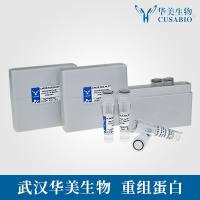Determination of Molecular Size by Zonal Sedimentation Analysis on Sucrose Density Gradients
互联网
- Abstract
- Table of Contents
- Materials
- Figures
- Literature Cited
Abstract
The molecular weight of a protein is a basic characteristic that can only be approximated by techniques such as gel filtration and electrophoresis. Zonal sedimentation analysis on sucrose gradients is a method for estimating the molecular mass of proteins and protein complexes under nondenaturing conditions. This unit includes protocols for preparing the appropriate gradients, for fractionation and separation of cell lysates on the gradients, for fractionation of the gradients themselves, and use of the results to calculate the molecular mass based on sedimentation coefficient and other parameters. There is also an additional protocol for differential sedimentation on gradients made with water and deuterium oxide to allow for direct determination of the partial specific volume of a protein or complexes.
Table of Contents
- Basic Protocol 1: Zonal Sedimentation Using Sucrose Gradient Formed by a Gradient Master
- Alternate Protocol 1: Zonal Sedimentation Using Sucrose Gradients Formed by a Gradient Maker
- Support Protocol 1: Use and Preparation of Common Molecular Size Makers
- Basic Protocol 2: Fractionation by Puncture and Elution from the Bottom of the Gradient
- Alternate Protocol 2: Fractionation by Peristalitic Elution from the Bottom of the Gradient
- Alternate Protocol 3: Manual Fractionation by Removal of Material from the Top of the Gradient
- Support Protocol 2: Determination of Sedimentation Coefficients by Extrapolation from Migration from of Standard Proteins
- Support Protocol 3: Determination of the Value of ST,m
- Support Protocol 4: Determination of the Value of Partial Specific Volume (υ)
- Support Protocol 5: Determination of the Value of S20,w
- Basic Protocol 3: Determination of Partial Specific Volume and Sedimentation Coefficient by Parallel Sedimentation in Media with Different Densities
- Commentary
- Figures
- Tables
Materials
Basic Protocol 1: Zonal Sedimentation Using Sucrose Gradient Formed by a Gradient Master
Materials
Alternate Protocol 1: Zonal Sedimentation Using Sucrose Gradients Formed by a Gradient Maker
Support Protocol 1: Use and Preparation of Common Molecular Size Makers
Basic Protocol 2: Fractionation by Puncture and Elution from the Bottom of the Gradient
Materials
Alternate Protocol 2: Fractionation by Peristalitic Elution from the Bottom of the Gradient
Alternate Protocol 3: Manual Fractionation by Removal of Material from the Top of the Gradient
Support Protocol 2: Determination of Sedimentation Coefficients by Extrapolation from Migration from of Standard Proteins
Materials
Support Protocol 3: Determination of the Value of ST,m
Materials
Support Protocol 4: Determination of the Value of Partial Specific Volume (υ)
Materials
Support Protocol 5: Determination of the Value of S20,w
Materials
|
Figures
-

Figure 5.3.1 Formation of sucrose gradients with manual gradient maker. A typical apparatus is diagrammed. The dense (darker) material is in chamber 2 (2), and the less dense material is in chamber 1 (1). Material is kept constantly stirred by adding a stir bar (sb) in chamber 1 and placing chamber 1 over an electric stirrer as indicated. Stopcocks (sc) regulate the flow between the chambers and out of chamber 1. Microbore tubing and a glass capillary micropipet carry the material into the gradient tube. View Image
Videos
Literature Cited
| Literature Cited | |
| Buchner, J., Renner, M., Lilie, H., Hinz, H.‐J., Jaeniche, R., Kiefhaler, T., and Rudolph, R. 1991. Alternatively folded states of an immunoglobulin. Biochemistry 30:6922‐6929. | |
| Clarke, S. 1975. The size and detergent binding of membrane proteins. J. Biol. Chem. 250:5459‐5469. | |
| Cohn, E.J. and Edsall, J.T. 1943. Density and apparent specific volume of proteins. In Proteins, Amino Acids, and Peptides as Ions and Dipolar Ions (E.J. Cohn and J.T. Edsall, eds.) pp.370‐381. Harvard Publishing, New York. | |
| Coombs, D.H. and Watts, N.R. 1985. Generating sucrose gradients in three minutes by tilted tube rotation. Anal. Biochem. 148:254‐259. | |
| de Haen, C. 1987. Molecular weight standards for calibration of gel filtration and sodium dodecyl sulfate‐polyacrylamide gel electrophoresis: ferritin and apoferritin. Anal. Biochem. 166:235‐245. | |
| Doms, R.W. 1990. Oligomerization and protein transport. Methods Enzymol. 191:841‐854. | |
| Edelstein, S.J. and Schachman, H.K. 1967. The simultaneous determination of partial specific volumes and molecular weights with microgram quantities. J. Biol. Chem. 242:306‐311. | |
| Gething, M.J. and Sambrook, J. 1992. Protein folding in the cell. Nature 355:33‐45. | |
| Gibbons, R.A. 1972. Physico‐chemical methods for the determination of the purity, molecular size and shape of glycoproteins. In Glycoproteins: Their Composition, Structure, and Function (A. Gottschalk, ed.) pp. 31‐128. Elsevier/North Holland, Amsterdam. | |
| Hall, P.K. and Roberts, R.C. 1978. Physical and chemical properties of human plasma α2‐macroglobulin. Biochem. J. 171:27‐38. | |
| Hartl, U.F. 1996. Molecular chaperones in cellular protein folding. Nature 381:571‐579. | |
| Helenius, A. and Simons, K. 1975. Solubilization of membranes by detergents. Biochim. Biophys. Acta 415:29‐79. | |
| Horne, W.A., Weiland, G.A., and Oswald, R.E. 1986. Solubilization and hydrodynamic characterization of the dihydropyridine receptor from rat ventricular muscle. J. Biol. Chem. 261:3588‐3594. | |
| Keller, R.K. and Touster, O. 1975. Physical and chemical properties of β‐glucuronidase from the preputial gland of the female rat. J. Biol. Chem. 250:4765‐4769. | |
| Lide, D.R. 1997. CRC Handbook of Chemistry and Physics, 78th ed. CRC Press, Boca Raton, Fla. | |
| Lundh, S. 1973. Determination of the molecular weight and partial specific volume of human transferrin by means of a new two‐stage density gradient equilibrium method. Int. J. Peptide Protein Res. 5:304‐325. | |
| Martin, R.G. and Ames, B.N. 1961. A method for determining the sedimentation behavior of enzymes: Application to protein mixtures. J. Biol. Chem. 236:1372‐1379. | |
| Meunier, J.C., Olsen, R.W., and Changeux, J.P. 1972. Studies on the cholinergic receptor protein from Electrophorus electricus. Effect of detergents on some hydrodynamic properties of the receptor protein in solution. FEBS Lett. 24:63‐68. | |
| Millero, F.J., Ward, G.K., and Chetirkin, P. 1976. Partial specific volume, expansibility, compressibility, and heat capacity of aqueous lysozyme solutions. J. Biol. Chem. 251:4001‐4004. | |
| Neugebauer, J. 1994. A Guide to the Properties and Uses of Detergents in Biology and Biochemistry. Calbiochem‐Novabiochem International, La Jolla, Calif. | |
| Reisler, E., Haik, Y., and Eisenberg, H. 1977. Bovine serum albumin and aqueous guanidine hydrochloride solutions. Preferential and absolute interactions and comparison with other systems. Biochemistry 16:197‐203. | |
| Roche, P.A., Marks, M.S., and Cresswell, P. 1991. Formation of a nine‐subunit complex by HLA class II glycoproteins and the invariant chain. Nature 354:392‐394. | |
| Sober, H.A.. 1970. CRC Handbook of Biochemistry. Selected Data for Molecular Biology, 2nd ed. CRC Press, Boca Raton, Fla. | |
| Tanford, C. 1961. Physical Chemistry of Macromolecules. John Wiley & Sons, New York. | |
| Tanford, C. and Reynolds, J.A. 1976. Characterization of membrane proteins in detergent solutions. Biochim. Biophys. Acta 457:133‐170. | |
| van Holde, K.E. 1975. Sedimentation analysis of proteins. In The Proteins, 3rd ed., Vol.1 (H. Neurath and R.L. Hill, eds.) pp.225‐291. Academic Press, New York. | |
| Watts, T.H., Kay, C.M., and Paranchych, W. 1982. Dissociation and characterization of pilin isolated from Pseudomonas aeruginosa strains PAK and PAO. Can. J. Biochem. 60:867‐872. | |
| Williams, J.W. 1972. Ultracentrifugation of Macromolecules. Academic Press, New York. | |
| Key References | |
| Helenius and Simons, 1975. See above. | |
| This is an excellent review covering the properties of detergents and how they bind to integral membrane proteins. It should be used as a guide for interpreting sedimentation experiments of integral membrane proteins in detergent solutions. | |
| Martin and Ames, 1961. See above. | |
| This is the seminal paper describing the technique of zonal sedimentation in sucrose gradients and supplies most of the basic background for understanding and performing the technique. | |
| van Holde, 1975. See above. | |
| This is an excellent review article covering the theoretical aspects of all of the major methods for sedimentation analysis of macromolecules. | |
| Internet Resource | |
| http://131.202.97.21 | |
| The Biocomp home page describes the Biocomp Gradient Master and Piston Gradient Fractionator with trumpet tip in detail. |







